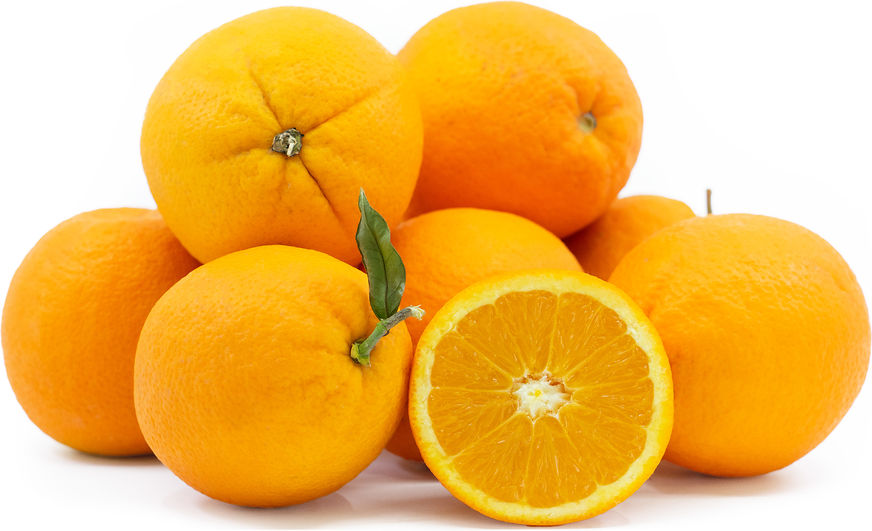


Fukumoto Navel Oranges
Estimated Inventory, lb : 0
Description/Taste
Fukumoto navel oranges are small to medium in size, averaging 5-8 centimeters in diameter, and are spherical to oblate in shape with a rounded depression, also known as a navel, on the blossom stem end. The navel may appear inward when small, and as the fruit grows, it can gradually extend outward creating a slight protrusion. The medium-thick rind has a vibrant red-orange hue and is leathery and rough with a pebbled texture due to the presence of many oil glands. Underneath the surface of the rind, the white pith is spongy, compact, and easily removed from the flesh. The pulp or flesh is soft, juicy, seedless, and divided into 10-12 segments by thin white membranes. Fukumoto navel oranges are highly aromatic with many essential oils found in the rind and have a low acid content creating a sweet flavor.
Seasons/Availability
Fukumoto navel oranges are available in the late fall through winter.
Current Facts
Fukumoto oranges, botanically classified as Citrus sinensis, are a navel variety that grows on evergreen trees and are members of the Rutaceae or citrus family. Originally from Japan, Fukumoto navel oranges were discovered as a mutation on a Washington navel orange tree and were introduced to the United States citrus market in hopes of introducing an adaptable and hardy navel variety. While Fukumoto oranges have not achieved commercial success in the United States, it has found a niche in the home gardening market for its ability to be grown in containers. Fukumoto navel oranges are favored for their rich red-orange skin, large size, seedless nature, and are also an early maturing variety that can be harvested 3-4 weeks before the Washington navel.
Nutritional Value
Fukumoto navel oranges are an excellent source of vitamin C and also contain vitamin A, calcium, potassium, and fiber.
Applications
Fukumoto navel oranges are best suited for both raw and cooked applications such as braising, roasting, and poaching. The oranges are most popularly consumed fresh, out-of-hand and are easily peeled and segmented. They can also be segmented and tossed into green salads, fruit bowls, and grain bowls, layered on cheese boards, or sprinkled over yogurt, ice cream, tacos, and cooked meats. When cooked, Fukumoto navel oranges can be poached in a simple syrup or roasted to create a caramelized outer shell to create sweet desserts. In addition to fresh and cooked applications, Fukumoto navel oranges can be squeezed for their juice and consumed as is or used to make cocktails, smoothies, sorbets, marinades, and sauces. The juice can also be used to add sweetness and acidity to salsas, salad dressings, and ceviche. Fukumoto navel oranges pair well with meats such as grilled fish, pork, poultry, and steak, ginger, pistachios, pine nuts, sesame seeds, Greek yogurt, quinoa, mint, basil, and cilantro. The fruit will keep up to a week at room temperature and 2-4 weeks when stored in the refrigerator.
Ethnic/Cultural Info
The Fukumoto navel orange was proven successful in Japan and was originally brought to the United States with the hope that its larger size and deep color would yield an improved naval orange cultivar for the commercial citrus market. While the Fukumoto proved to be an early season producer maturing weeks before the Washington navel, it did not produce the desired large fruit and instead began to produce smaller fruit than in Japan, exhibited bark rot syndrome, and often developed the navel orange disease chimera. Testing continues to see if importing new strains of Fukumoto from abroad can in time yield a fruit that will be a commercial success in the citrus growing regions of the United States. Fukumoto navel oranges are being tested and grown today at the University of California Riverside and affiliate growers, as well as by a handful of small farms and home growers.
Geography/History
The original Fukumoto navel orange is believed to have been a naturally occurring mutation found on a Washington navel tree in the garden of S. Fukumoto in the 1960s in the Wakayama prefecture of Japan. In 1983, it was donated to American doctor W.P. Bitters who selected the orange from a display of Japanese citrus and had it brought to the United States Department of Agriculture’s Glenn Dale quarantine. After spending years in quarantine, being tested for various citrus diseases, the Fukumoto was released in September of 1986. In 1990, it was released in California to the University of California Riverside where it has since been in development as plant breeders are trying to find a Fukumoto variety capable of being commercially successful in the California citrus region. Today Fukumoto navel oranges are available at local markets in Japan and in limited quantities at farmers markets in California in the United States.




